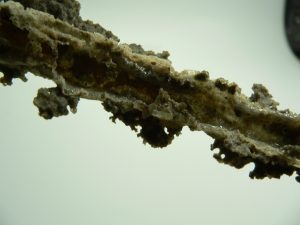Natural glass: Fulgurit - German/German

This bizarre glass exhibit was created without human intervention. It is called fulgurite or lightning tube, derived from Latin "fulgur", the lightning. It was found in the Rebianna Murzuk sand lake in Libya. As the name and the place of discovery already suggest, such tubular fulgurites are formed by lightning strikes in sand lakes or sand deserts. The decisive factor is the rapid cooling of the high temperatures of up to 30,000 degrees Celsius generated by the lightning strike, whereby the walls of the tube vitrify. Fulgurites are on average only two centimetres wide, but can grow up to several metres long.
Natural Glass: Fulgurite - English

This bizarre glass exhibit was created without human intervention. It's described as Fulgurite, or lightning tubes and is derived from the Latin, "fulgur", meaning the flash. It was found in the Rebiana Sand Sea in Libya. As the name and source suggest, tube-shaped fulgurite like this is created when lightning strikes the sand seas or sandy deserts. The rapid cooling of the high temperatures of up to 30,000 degrees Celsius created when lightning strikes, is the decisive factor in the process, because it causes the tubes to vitrify. Fulgurite is just 2 centimetres wide on average, but can be several metres long.